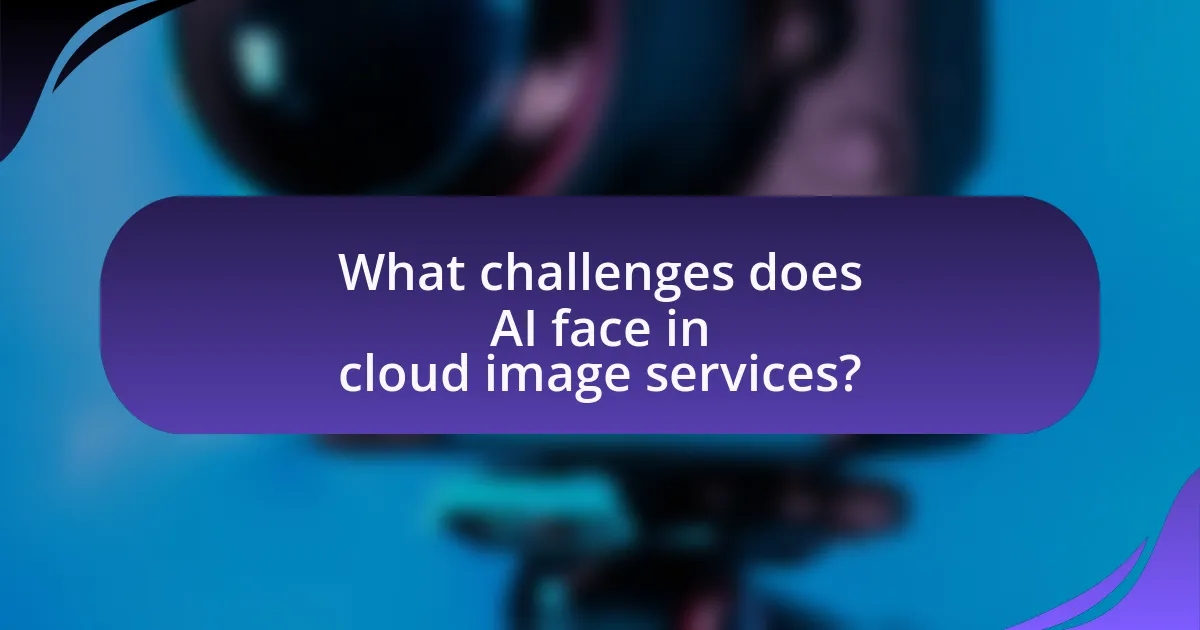The article focuses on the role of artificial intelligence (AI) in enhancing cloud image services. It outlines how AI automates image processing tasks, improves image quality, and enables advanced analytics, leading to increased efficiency in image management. Key topics include the integration of machine learning algorithms for image categorization and enhancement, the technologies that facilitate this integration, and the benefits such as improved image recognition and storage efficiency. Additionally, the article addresses challenges like data privacy concerns and algorithm bias, while also exploring future trends and best practices for implementing AI in cloud image services.
What is the Role of AI in Enhancing Cloud Image Services?

AI plays a crucial role in enhancing cloud image services by automating image processing tasks, improving image quality, and enabling advanced analytics. For instance, AI algorithms can automatically categorize and tag images, making them easier to search and retrieve. Additionally, machine learning techniques enhance image resolution and clarity through upscaling and noise reduction. According to a report by MarketsandMarkets, the AI in the cloud image processing market is projected to grow from $1.2 billion in 2020 to $4.5 billion by 2025, indicating a significant demand for AI-driven solutions in this sector.
How does AI integrate with cloud image services?
AI integrates with cloud image services by utilizing machine learning algorithms to analyze, categorize, and enhance images stored in the cloud. These algorithms enable features such as automated tagging, image recognition, and content moderation, which improve the efficiency and accuracy of image management. For instance, cloud platforms like Google Cloud Vision and Amazon Rekognition leverage AI to provide real-time image analysis, allowing users to search and retrieve images based on visual content rather than metadata alone. This integration not only streamlines workflows but also enhances user experience by delivering personalized content recommendations based on image analysis.
What technologies enable AI integration in cloud image services?
Technologies that enable AI integration in cloud image services include machine learning algorithms, computer vision frameworks, and cloud computing infrastructure. Machine learning algorithms, such as convolutional neural networks (CNNs), are essential for image recognition and classification tasks. Computer vision frameworks, like OpenCV and TensorFlow, provide tools for processing and analyzing images, facilitating tasks such as object detection and image segmentation. Additionally, cloud computing infrastructure offers scalable resources and storage, allowing for the efficient processing of large datasets required for training AI models. These technologies collectively enhance the capabilities of cloud image services by enabling advanced features like automated tagging, image enhancement, and real-time analysis.
How does AI improve image processing in the cloud?
AI improves image processing in the cloud by enabling faster and more accurate analysis and enhancement of images through advanced algorithms. These algorithms, such as convolutional neural networks (CNNs), can automatically identify and classify objects within images, significantly reducing the time required for manual processing. For instance, AI-driven tools can enhance image resolution, remove noise, and apply filters in real-time, which is particularly beneficial for applications like medical imaging and satellite imagery. According to a study published in the journal “IEEE Transactions on Image Processing,” AI techniques can achieve up to 30% improvement in processing speed and accuracy compared to traditional methods, demonstrating the effectiveness of AI in optimizing cloud-based image services.
What are the key benefits of using AI in cloud image services?
The key benefits of using AI in cloud image services include enhanced image recognition, improved storage efficiency, and automated image tagging. Enhanced image recognition allows for more accurate identification and classification of images, which is crucial for applications like facial recognition and object detection. Improved storage efficiency is achieved through AI-driven compression techniques that reduce file sizes without compromising quality, optimizing storage costs. Automated image tagging utilizes machine learning algorithms to analyze and label images, streamlining workflows and making it easier to search and retrieve images. These benefits collectively lead to increased productivity and better user experiences in managing and utilizing image data.
How does AI enhance image quality and resolution?
AI enhances image quality and resolution through advanced algorithms that analyze and reconstruct images. These algorithms, such as convolutional neural networks (CNNs), can identify patterns and details in low-resolution images, allowing for upscaling without significant loss of quality. For instance, AI techniques like super-resolution have been shown to increase image resolution by up to four times while preserving fine details, as demonstrated in studies like “Image Super-Resolution Using Deep Learning” by Ledig et al. (2017). This capability is particularly valuable in cloud image services, where high-quality visuals are essential for user engagement and satisfaction.
What impact does AI have on image retrieval and organization?
AI significantly enhances image retrieval and organization by improving accuracy and efficiency in searching and categorizing images. Machine learning algorithms analyze image content, enabling automatic tagging and classification based on visual features, which reduces the time required for manual organization. For instance, AI can recognize objects, scenes, and even emotions within images, allowing for more intuitive search capabilities. According to a study published in the Journal of Visual Communication and Image Representation, AI-driven systems can achieve up to 90% accuracy in image classification tasks, demonstrating their effectiveness in managing large image datasets.
What challenges does AI face in cloud image services?

AI faces several challenges in cloud image services, including data privacy concerns, algorithm bias, and the need for high computational resources. Data privacy is critical as sensitive images may be processed, raising issues related to compliance with regulations like GDPR. Algorithm bias can lead to inaccurate image recognition or classification, affecting the reliability of AI applications. Additionally, high computational demands for processing large volumes of images can strain cloud infrastructure, leading to increased costs and potential service delays. These challenges highlight the complexities involved in integrating AI effectively within cloud image services.
How do data privacy concerns affect AI in cloud image services?
Data privacy concerns significantly impact AI in cloud image services by necessitating stricter data handling protocols and influencing user trust. These concerns lead to the implementation of robust encryption methods and compliance with regulations such as GDPR, which require organizations to ensure that personal data is processed lawfully and transparently. For instance, a study by the International Association of Privacy Professionals highlights that 79% of consumers are concerned about how their data is used, prompting cloud service providers to adopt privacy-centric AI solutions that minimize data exposure and enhance user control over personal information.
What measures can be taken to ensure data security?
To ensure data security, organizations should implement strong encryption protocols for data at rest and in transit. Encryption protects sensitive information from unauthorized access, making it unreadable without the appropriate decryption keys. According to a 2021 report by the Ponemon Institute, 60% of organizations that implemented encryption experienced fewer data breaches compared to those that did not. Additionally, regular security audits and vulnerability assessments can identify potential weaknesses in the system, allowing for timely remediation. Implementing multi-factor authentication further enhances security by requiring multiple forms of verification before granting access to sensitive data. These measures collectively create a robust framework for safeguarding data against breaches and unauthorized access.
How do regulations influence AI deployment in cloud image services?
Regulations significantly influence AI deployment in cloud image services by establishing legal frameworks that govern data privacy, security, and ethical use. For instance, the General Data Protection Regulation (GDPR) in Europe mandates strict guidelines on how personal data, including images, can be processed and stored, compelling cloud service providers to implement robust data protection measures. Compliance with such regulations often requires the integration of advanced AI technologies that can ensure data anonymization and secure processing, thereby shaping the development and deployment strategies of AI in these services.
What are the limitations of AI in enhancing cloud image services?
AI has limitations in enhancing cloud image services primarily due to issues related to data quality, interpretability, and computational constraints. The effectiveness of AI algorithms heavily relies on the availability of high-quality, diverse datasets; poor data quality can lead to inaccurate image processing and analysis. Additionally, many AI models operate as “black boxes,” making it difficult for users to understand how decisions are made, which can hinder trust and usability. Furthermore, the computational resources required for training and deploying sophisticated AI models can be prohibitive, especially for smaller organizations, limiting their ability to leverage AI effectively in cloud image services.
How does the quality of training data impact AI performance?
The quality of training data significantly impacts AI performance by determining the accuracy and reliability of the model’s predictions. High-quality training data, characterized by relevance, diversity, and cleanliness, enables AI systems to learn effectively and generalize well to new, unseen data. For instance, a study by Amodei et al. (2016) at OpenAI demonstrated that models trained on diverse and representative datasets outperformed those trained on biased or limited data, leading to a 20% increase in accuracy in image recognition tasks. Thus, the integrity of training data directly correlates with the effectiveness of AI applications in enhancing cloud image services.
What are the computational challenges associated with AI in cloud image services?
The computational challenges associated with AI in cloud image services include high processing demands, data transfer latency, and resource allocation inefficiencies. High processing demands arise from the need for complex algorithms to analyze and process large volumes of image data, which can strain cloud infrastructure. Data transfer latency occurs due to the time required to upload and download large image files, impacting real-time processing capabilities. Resource allocation inefficiencies can result from the dynamic nature of AI workloads, leading to underutilization or overloading of cloud resources. These challenges necessitate advanced optimization techniques and robust infrastructure to ensure efficient AI deployment in cloud image services.
What future trends can we expect in AI and cloud image services?

Future trends in AI and cloud image services include increased automation, enhanced image recognition capabilities, and improved personalization. Automation will streamline workflows, allowing for faster processing and analysis of images, which is essential for industries like e-commerce and healthcare. Enhanced image recognition, driven by advancements in deep learning algorithms, will enable more accurate tagging and categorization of images, facilitating better search and retrieval. Improved personalization will leverage AI to tailor image content to individual user preferences, enhancing user engagement and satisfaction. These trends are supported by the growing adoption of AI technologies in cloud platforms, as evidenced by a report from Gartner indicating that by 2025, 75% of organizations will be using AI in their cloud services.
How will advancements in AI technology shape cloud image services?
Advancements in AI technology will significantly enhance cloud image services by improving image recognition, processing speed, and personalization. AI algorithms can analyze and categorize images with high accuracy, enabling faster retrieval and organization of vast image databases. For instance, machine learning models can automatically tag images based on content, which streamlines workflows for businesses that rely on large volumes of visual data. Additionally, AI-driven enhancements such as automated image editing and optimization can improve the quality of images stored in the cloud, making them more suitable for various applications. According to a report by MarketsandMarkets, the AI in the cloud market is expected to grow from $1.5 billion in 2020 to $7.5 billion by 2025, indicating a strong trend towards integrating AI capabilities in cloud services, including image management.
What role will machine learning play in future cloud image enhancements?
Machine learning will play a pivotal role in future cloud image enhancements by enabling automated image processing, improving image quality, and facilitating real-time analysis. This technology allows for advanced algorithms to learn from vast datasets, leading to better noise reduction, enhanced resolution, and optimized color correction. For instance, machine learning models can analyze patterns in images to automatically adjust parameters, resulting in superior visual outputs. Research has shown that machine learning techniques, such as convolutional neural networks, significantly outperform traditional methods in tasks like image classification and enhancement, demonstrating their effectiveness in cloud-based applications.
How might user expectations evolve with AI advancements?
User expectations will likely evolve towards demanding more personalized, efficient, and intuitive interactions with AI systems as advancements occur. As AI technology improves, users will expect faster processing times, higher accuracy in image recognition, and more tailored recommendations based on their preferences. For instance, studies show that 70% of consumers prefer personalized experiences, indicating a strong trend towards customization in service delivery. Additionally, as AI becomes more integrated into cloud image services, users will anticipate seamless integration across devices and platforms, enhancing their overall experience.
What best practices should be followed when implementing AI in cloud image services?
When implementing AI in cloud image services, best practices include ensuring data privacy and security, optimizing algorithms for performance, and maintaining transparency in AI decision-making processes. Data privacy and security are critical, as cloud services often handle sensitive information; compliance with regulations such as GDPR is essential. Optimizing algorithms enhances processing speed and accuracy, which is vital for user satisfaction and operational efficiency. Transparency in AI processes builds trust with users, allowing them to understand how decisions are made, which is supported by studies indicating that transparency can improve user acceptance of AI technologies.
How can organizations ensure effective AI integration in their cloud image services?
Organizations can ensure effective AI integration in their cloud image services by implementing a structured approach that includes selecting the right AI tools, ensuring data quality, and fostering collaboration between IT and business teams. Selecting AI tools that are specifically designed for image processing, such as computer vision algorithms, enhances the capability to analyze and categorize images efficiently. Ensuring data quality is crucial, as high-quality, labeled datasets improve the accuracy of AI models, leading to better performance in tasks like image recognition and classification. Additionally, fostering collaboration between IT and business teams ensures that the AI solutions align with organizational goals and user needs, facilitating smoother integration and adoption.
What strategies can enhance user experience with AI-driven cloud image services?
To enhance user experience with AI-driven cloud image services, implementing personalized content recommendations is crucial. Personalization leverages user data to suggest images or edits tailored to individual preferences, significantly improving engagement. For instance, a study by McKinsey found that personalization can lead to a 10-30% increase in customer satisfaction and retention. Additionally, optimizing image processing speed through AI algorithms reduces latency, allowing users to access and manipulate images more efficiently. Research indicates that faster load times can enhance user satisfaction by up to 70%. Lastly, incorporating intuitive user interfaces that utilize AI for automated tagging and organization simplifies the user experience, making it easier for users to find and manage their images.



